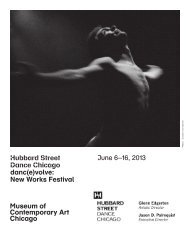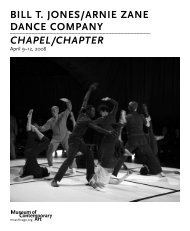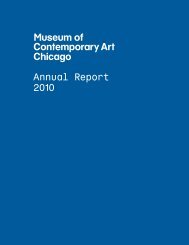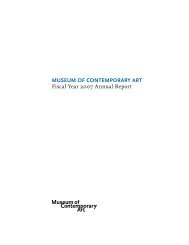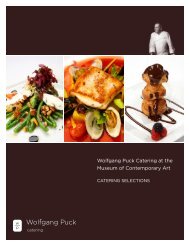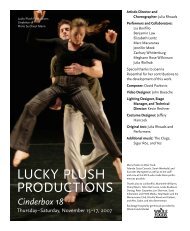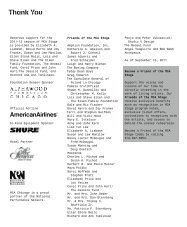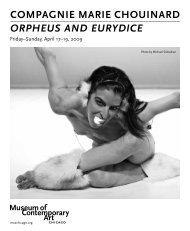Program Notes - Museum of Contemporary Art, Chicago
Program Notes - Museum of Contemporary Art, Chicago
Program Notes - Museum of Contemporary Art, Chicago
Create successful ePaper yourself
Turn your PDF publications into a flip-book with our unique Google optimized e-Paper software.
Photo: Joshua Bright<br />
ICE (International<br />
<strong>Contemporary</strong> Ensemble):<br />
George Lewis and Friends<br />
Sunday,<br />
February 5, 2012
Photo: Carrie Schneider
George Lewis<br />
and Friends<br />
Steven Schick, conductor<br />
Steve Lehman, saxophone<br />
Tyshawn Sorey,<br />
trombone ⁄percussion<br />
Nicole M. Mitchell, flute<br />
George E. Lewis<br />
<strong>Art</strong>ificial Life 2007<br />
for ensemble (2007)<br />
<strong>Chicago</strong> premiere<br />
Steve Lehman<br />
Impossible Flow<br />
for ensemble (2010, rev.<br />
2011; ICElab commission)<br />
<strong>Chicago</strong> premiere<br />
Nicole M. Mitchell<br />
Cave <strong>of</strong> Self-Induction<br />
for two flutes and<br />
percussion (2012)<br />
World premiere<br />
Tyshawn Sorey<br />
Ode to Gust Burns<br />
for bassoon, piano,<br />
percussion, guitar, and<br />
trombone (2012;<br />
ICElab commission)<br />
World premiere<br />
George E. Lewis<br />
The Will to Adorn<br />
for ensemble (2011, rev. 2012)<br />
<strong>Chicago</strong> premiere<br />
This concert runs<br />
approximately 75 minutes<br />
without intermission.<br />
ICE (International<br />
<strong>Contemporary</strong> Ensemble)<br />
Eric Lamb, flute<br />
Claire Chase, flute<br />
Joshua Rubin, clarinet<br />
Rebekah Heller, bassoon<br />
David Byrd-Marrow, horn<br />
Gareth Flowers, trumpet<br />
Mike Lormand, trombone<br />
Cory Smythe, piano<br />
Erik Carlson, violin<br />
Katinka Kleijn, cello<br />
Tony Flynt, bass<br />
Dan Lippel, guitar<br />
Nathan Davis, percussion<br />
Ross Karre, percussion<br />
Support for this project is generously<br />
provided by Katherine A.<br />
Abelson and Robert J. Cornell and<br />
the Amphion Foundation, Inc. Additional<br />
generous support is provided<br />
by the National Endowment<br />
for the <strong>Art</strong>s.<br />
ICElab 2012 is made possible<br />
through lead support from The<br />
Andrew W. Mellon Foundation,<br />
alongside generous funding from<br />
the Greenwall Foundation, the<br />
Creative Capital Multi-<strong>Art</strong>s<br />
Production (MAP) Fund, the<br />
National Endowment for the <strong>Art</strong>s,<br />
the French American Cultural<br />
Exchange, the Alice M. Ditson<br />
Fund, and public funds from<br />
the New York City Department <strong>of</strong><br />
Cultural Affairs in partnership<br />
with the City Council.<br />
Tyshawn Sorey’s participation<br />
in ICElab is supported by the<br />
Greenwall Foundation.<br />
Steve Lehman’s Impossible Flow<br />
was commissioned jointly by<br />
the Manhattan New Music Project<br />
and ICE.<br />
Join us for the final<br />
concert <strong>of</strong> ICE’s 2011/12<br />
season at MCA Stage.<br />
Georges Aperghis<br />
and the New Generation<br />
Saturday, May 26,<br />
7:30 pm<br />
Georges Aperghis’s<br />
aggressive yet playful<br />
experimental music<br />
pushes the boundaries<br />
between classical performance<br />
and performance<br />
art. The ensemble performs<br />
the <strong>Chicago</strong> premiere<br />
<strong>of</strong> a major new<br />
ICE-commissioned work<br />
from Aperghis, plus two<br />
new chamber works by<br />
ICElab 2012 composers<br />
Patricia Alessandrini and<br />
Juan Pablo Carreño.
Teatr ZAR<br />
The Gospels <strong>of</strong><br />
Childhood Triptych<br />
Mar 29–Apr 1, 2012<br />
Theater<br />
Music<br />
Presented by MCA Stage<br />
in association with Goodman Theatre<br />
“pr<strong>of</strong>oundly moving …<br />
echoing from the deep,<br />
deep past with the<br />
evanescent present”<br />
New Theatre Quarterly<br />
Photo: Irena Lipinska<br />
For tickets, visit mcachicago.org or call 312.397.4010.<br />
Support for this project is generously provided by the<br />
Consulate General <strong>of</strong> Poland in <strong>Chicago</strong>.
About the program<br />
George E. Lewis: <strong>Art</strong>ificial Life 2007 (2007)<br />
Created for the Glasgow Improvisers Orchestra,<br />
<strong>Art</strong>ificial Life 2007 is a schema for collective improvisation—and<br />
collective silence. No musical<br />
material is prescribed; the principle is stimulus,<br />
and the medium is verbal instructions that give<br />
rise to radically different results, depending on<br />
the performers taking part.<br />
There are just two pages to these instructions,<br />
which may be followed separately, in either<br />
order, or together. Page 1 is to be read by musicians<br />
acting individually or in groups, and is the<br />
same for everyone: a set <strong>of</strong> sixteen words, some<br />
<strong>of</strong> them suggesting kinds <strong>of</strong> sound (“smooth,”<br />
“soli”), some having to do with how one soloist<br />
or group might respond to one another (“end,”<br />
for example, asks for an imitative response to<br />
another group, starting immediately as that other<br />
group has come to an end). Page 2 consists <strong>of</strong><br />
single words or very elementary directions and<br />
proposes several groups (at least three) each<br />
create a pathway either in relation to what is happening<br />
or independently.<br />
Lewis further suggests that moments <strong>of</strong> silence<br />
will be needed—not empty silence, but a silence<br />
filled with listening and decision-making as the<br />
musicians prepare to contribute to the artificial<br />
life that is their joint creation. “The success <strong>of</strong> the<br />
performance,” the composer finally notes, “is not<br />
so much related to individual freedoms but to the<br />
assumption <strong>of</strong> personal and collective responsibility<br />
for the sonic environment.”<br />
© Paul Griffiths, http://disgwylfa.com<br />
Steve Lehman: Impossible Flow<br />
(2010, rev. 2012)<br />
“In Impossible Flow, delicate and highly nuanced<br />
spectral harmonies are integrated into a series <strong>of</strong><br />
meticulously crafted rhythmic environments. Expressive<br />
timing, compound meter, rubato phrasing,<br />
changing tempi, irrational rhythms, and instrumental<br />
gesture are treated as a seamless continuum<br />
designed to explore the psychology <strong>of</strong> musical<br />
time and its connection to the elision <strong>of</strong> timbre and<br />
harmony in spectral music. By imagining Impossible<br />
Flow in this way, I hope to create an elaborate<br />
sense <strong>of</strong> directionality and form that remains rooted<br />
in the physicality <strong>of</strong> live performance and the<br />
corporeal nature <strong>of</strong> urban rhythmic sensibilities.”<br />
—Steve Lehman<br />
Nicole M. Mitchell: Cave <strong>of</strong><br />
Self-Induction (2012)<br />
“Before thought, before the birth <strong>of</strong> an idea, one<br />
enters a dark cave <strong>of</strong> formlessness, <strong>of</strong> timeless<br />
and endless potential. The cave is where all<br />
minds meet, where all minds have met, in search<br />
<strong>of</strong> Source, before sound, before self, before<br />
manifestation’s beginning.”<br />
—Nicole M. Mitchell<br />
Tyshawn Sorey: Ode to Gust Burns<br />
(2012; ICElab commission)<br />
“Eight years ago, on a cold, rainy day in New York<br />
City, the pianist Vijay Iyer and I decided to listen<br />
to some music together at his apartment; we<br />
listened to a CD containing four solo improvisations<br />
by Seattle-based pianist/composer Gust<br />
Burns, whose music was astonishingly beautiful.<br />
Burns creates a unique dialogue between gesture<br />
and rhythm in his improvisations. His approach<br />
to piano performance opens up a world<br />
<strong>of</strong> sound complexes, creating a fresh, relevant<br />
language <strong>of</strong> improvisation. Burns’s work continues<br />
to inspire me as an improviser and composer,<br />
and Ode to Gust Burns directly deals with<br />
my initial exposure to his music.”<br />
—Tyshawn Sorey
George E. Lewis: The Will to Adorn<br />
(2011, rev. 2012)<br />
Lewis has taken the title for his new piece from<br />
a 1934 essay by Zora Neale Hurston, “Characteristics<br />
<strong>of</strong> Negro Expression” (available online).<br />
Key phrases for Lewis are: “The stark, trimmed<br />
phrases <strong>of</strong> the Occident seem too bare,” “decorating<br />
a decoration,” and “one always finds a<br />
glut <strong>of</strong> gaudy calendars.” However, the identification<br />
<strong>of</strong> “the will to adorn” as characteristic <strong>of</strong> a<br />
particular racial-cultural group—an identification<br />
no doubt defensible eight decades ago as an assertion<br />
<strong>of</strong> identity—is here not accepted without<br />
question.<br />
Describing his interest as “adornment as a compositional<br />
attitude or method,” Lewis distances<br />
himself from any naive view <strong>of</strong> it as a marker,<br />
and his references include not only “those amazing<br />
church hats worn by African American women”<br />
but also ideas <strong>of</strong> “saturation” put forward by<br />
the French composer Franck Bedrossian.<br />
He has further proposed the following longer<br />
quotation from Hurston’s essay as relevant to his<br />
composition:<br />
I saw in Mobile a room in which there was an<br />
over-stuffed mohair living-room suite, an imitation<br />
mahogany bed and chifferobe, a console<br />
victrola. The walls were gaily papered<br />
with Sunday supplements <strong>of</strong> the Mobile<br />
Register. There were seven calendars and<br />
three wall pockets. One <strong>of</strong> them was decorated<br />
with a lace doily. The mantel-shelf was<br />
covered with a scarf <strong>of</strong> deep home-made<br />
lace, looped up with a huge bow <strong>of</strong> pink<br />
crepe paper. Over the door was a huge lithograph<br />
showing the Treaty <strong>of</strong> Versailles being<br />
signed with a Waterman fountain pen.<br />
It was grotesque, yes. But it indicated the<br />
desire for beauwty. And decorating a decoration,<br />
as in the case <strong>of</strong> the doily on the gaudy<br />
wall pocket, did not seem out <strong>of</strong> place to the<br />
hostess. The feeling back <strong>of</strong> such an act is<br />
that there can never be enough <strong>of</strong> beauty, let<br />
alone too much.<br />
© Paul Griffiths, http://disgwylfa.com<br />
About the artists<br />
George E. Lewis<br />
serves as the Edwin H. Case Pr<strong>of</strong>essor <strong>of</strong> American<br />
Music and the Director <strong>of</strong> the Center for Jazz<br />
Studies at Columbia University. The recipient <strong>of</strong> a<br />
Mac<strong>Art</strong>hur Fellowship in 2002, an Alpert Award<br />
in the <strong>Art</strong>s in 1999, and fellowships from the<br />
National Endowment for the <strong>Art</strong>s, Lewis studied<br />
composition with Muhal Richard Abrams at the<br />
Association for the Advancement <strong>of</strong> Creative Musicians<br />
(AACM) School <strong>of</strong> Music, and trombone<br />
with Dean Hey. A member <strong>of</strong> the AACM since<br />
1971, Lewis’s work as composer, improvisor, performer,<br />
and interpreter explores electronic and<br />
computer music, computer-based multimedia<br />
installations, text-sound works, and notated and<br />
improvisative forms, and is documented on more<br />
than 120 recordings. His published articles on<br />
music, experimental video, visual art, and cultural<br />
studies have appeared in numerous scholarly<br />
journals and edited volumes. His book, Power<br />
Stronger Than Itself: The AACM and American<br />
Experimental Music, published by University <strong>of</strong><br />
<strong>Chicago</strong> Press, was released in fall 2007.<br />
Steve Lehman<br />
is a composer, performer, educator, and scholar<br />
who works across a broad spectrum <strong>of</strong> experi-
mental musical idioms. Lehman’s pieces for<br />
large orchestra and chamber ensembles have<br />
been performed by ICE (International <strong>Contemporary</strong><br />
Ensemble), So Percussion, Kammerensemble<br />
Neue Musik Berlin, The Jack String Quartet,<br />
members <strong>of</strong> the Argento and Wet Ink Ensembles,<br />
and the pianist Marilyn Nonken. An alto and<br />
sopranino saxophonist, Lehman has performed<br />
and recorded nationally and internationally with<br />
his own ensembles and with those led by Anthony<br />
Braxton, Dave Burrell, Mark Dresser, Vijay<br />
Iyer, Oliver Lake, Meshell Ndegeocello, and High<br />
Priest <strong>of</strong> Anti-Pop Consortium. Lehman is also a<br />
published scholar; his article in the journal Critical<br />
Studies in Improvisation, “I Love You with an<br />
Asterisk: African-American Experimental Composers<br />
and the French Jazz Press, 1970–1980,”<br />
is based on his Fulbright research in France.<br />
Lehman received his BA (2000) and MA in Composition<br />
(2002) from Wesleyan University where<br />
he studied under Anthony Braxton and Alvin<br />
Lucier, while concurrently working with Jackie<br />
McLean at the Hartt School <strong>of</strong> Music. Lehman<br />
is currently a doctoral candidate in Music Composition<br />
at Columbia University, where he is a<br />
departmental fellow and studies under Tristan<br />
Murail and George Lewis. His most recent recording,<br />
Travail, Transformation & Flow (Pi Records,<br />
2009), was chosen as the #1 Jazz Album<br />
<strong>of</strong> the year by The New York Times.<br />
Nicole Margaret Mitchell<br />
is a creative flutist, composer, and bandleader.<br />
She was named Top Flutist 2010 by Downbeat’s<br />
Critic’s Polls and placed first as Downbeat’s Rising<br />
Star Flutist 2005–2010. She was awarded<br />
Jazz Flutist <strong>of</strong> the Year 2010 by the Jazz Journalist<br />
Association and <strong>Chicago</strong>an <strong>of</strong> the Year<br />
2006 by the <strong>Chicago</strong> Tribune. The founder <strong>of</strong> the<br />
critically acclaimed Black Earth Ensemble and<br />
Black Earth Strings, Mitchell’s compositions<br />
reach across sound worlds, integrating new<br />
ideas with moments in the legacies <strong>of</strong> jazz, gospel,<br />
pop, and African percussion to create a fascinating<br />
synthesis <strong>of</strong> “postmodern jazz.” With her<br />
ensembles, as a featured flutist, and as a music<br />
educator, Mitchell has been a highlight at art<br />
venues, festivals throughout Europe, the United<br />
States, and Canada. Mitchell has performed<br />
with creative luminaries including George Lewis,<br />
Miya Masaoka, Lori Freedman, James Newton,<br />
Bill Dixon, and Muhal Richard Abrams. She also<br />
works on ongoing projects with Anthony Braxton,<br />
Ed Wilkerson, David Boykin, Rob Mazurek, Hamid<br />
Drake, and Avreeayl Ra.<br />
The first woman president <strong>of</strong> <strong>Chicago</strong>’s Association<br />
for the Advancement <strong>of</strong> Creative Musicians<br />
(AACM), Mitchell works to raise respect and<br />
integrity for the improvised flute, to contribute<br />
her innovative voice to the jazz legacy, and to<br />
continue the bold and exciting directions that the<br />
AACM has charted for decades.<br />
Tyshawn Sorey<br />
composes works that embrace a basic paradox<br />
in contemporary experimental music, bridging<br />
technical precision and an acute sense <strong>of</strong> space<br />
with the raw, virtuosic energy <strong>of</strong> improvisation<br />
central to his work in avant-jazz collectives such<br />
as Fieldwork and the Steve Lehman Octet. As a<br />
pianist, drummer, and trombonist, Sorey has performed<br />
alongside leading improvisers <strong>of</strong> our time,<br />
including John Zorn, Muhal Richard Abrams,<br />
Steve Coleman, and Anthony Braxton, and had<br />
his work featured in major festivals throughout<br />
the United States. His work as a composer and<br />
performer has been featured on recordings from<br />
Firehouse 12 and Pi Records. He is currently
studying at Columbia University.<br />
International <strong>Contemporary</strong> Ensemble (ICE)<br />
is dedicated to reshaping the way music is created<br />
and experienced. With a modular makeup <strong>of</strong><br />
thirty-three leading instrumentalists performing<br />
in forces ranging from solos to large ensembles,<br />
ICE functions as performer, presenter, and educator,<br />
advancing the music <strong>of</strong> our time by developing<br />
innovative new works and new strategies<br />
for audience engagement. ICE redefines concert<br />
music as it brings together new work and new<br />
listeners in the twenty-first century.<br />
Since its founding in 2001, ICE has premiered<br />
more than 500 compositions, the majority by<br />
emerging composers, in a range <strong>of</strong> venues<br />
around the world. The ensemble received the<br />
American Music Center’s Trailblazer Award<br />
in 2010 for its contributions to the field, and<br />
received the ASCAP/Chamber Music America<br />
Award for Adventurous <strong>Program</strong>ming in 2005<br />
and 2010. ICE is the ensemble-in-residence at<br />
MCA <strong>Chicago</strong> through 2013. The ICE musicians<br />
also serve as artists-in-residence at the Mostly<br />
Mozart Festival <strong>of</strong> Lincoln Center through 2013,<br />
curating and performing chamber music programs<br />
that juxtapose new and old music.<br />
ICE has released acclaimed albums on the<br />
Nonesuch, Kairos, Bridge, Naxos, Tzadik, New<br />
Focus, and New Amsterdam labels, with several<br />
forthcoming releases on Mode Records. Recent<br />
and upcoming highlights include headline performances<br />
at the Lincoln Center Festival (New<br />
York); Musica Nova Helsinki (Finland); Wien<br />
Modern (Austria); Acht Brücken Music for Cologne<br />
(Germany); La Cite de la Musique (Paris);<br />
and tours <strong>of</strong> Japan, Brazil, and France.<br />
ICE recently launched The Listening Room, a<br />
new educational initiative for public schools<br />
without in-house arts curricula. Using teambased<br />
composition and graphic notation, ICE<br />
musicians lead students in the creation <strong>of</strong> new<br />
compositions, nurturing collaborative creative<br />
skills and building an appreciation for musical<br />
experimentation. Read more at www.iceorg.org.<br />
Claire Chase, Executive Director<br />
Joshua Rubin, <strong>Program</strong> Director<br />
Eric H<strong>of</strong>f, Operations Manager<br />
Rose Bellini, Director <strong>of</strong> Development<br />
Jacob Greenberg, Education Director<br />
Steven Schick<br />
is a percussionist, conductor, and author, who<br />
was born in Iowa and raised in a farming family.<br />
For the past thirty years he has championed<br />
contemporary percussion music as a performer<br />
and teacher by commissioning and premiering<br />
more than one hundred new works for<br />
percussion. Schick is Distinguished Pr<strong>of</strong>essor<br />
<strong>of</strong> Music at the University <strong>of</strong> California, San<br />
Diego, and a Consulting <strong>Art</strong>ist in Percussion<br />
at the Manhattan School <strong>of</strong> Music. He was the<br />
percussionist <strong>of</strong> the Bang on a Can All-Stars<br />
<strong>of</strong> New York City from 1992 to 2002, and from<br />
2000 to 2004 served as <strong>Art</strong>istic Director <strong>of</strong> the<br />
Centre International de Percussion de Genève<br />
in Geneva, Switzerland. Schick is founder and<br />
<strong>Art</strong>istic Director <strong>of</strong> the percussion group red fish<br />
blue fish and director <strong>of</strong> “Roots and Rhizomes,”<br />
a summer course on contemporary percussion<br />
music hosted at the Banff Centre for the <strong>Art</strong>s. In<br />
2007 Schick assumed the post <strong>of</strong> Music Director<br />
and conductor <strong>of</strong> the La Jolla Symphony and<br />
Chorus, and in 2011 he became <strong>Art</strong>istic Director<br />
<strong>of</strong> the San Francisco <strong>Contemporary</strong> Music<br />
Players. Schick is the principal guest conductor<br />
<strong>of</strong> ICE (International <strong>Contemporary</strong> Ensemble).
Dance<br />
John Jota Leaños<br />
Imperial Silence:<br />
Una Ópera Muerta<br />
May 17–19, 2012<br />
“one <strong>of</strong> the most beautiful<br />
and seamless pieces <strong>of</strong><br />
performance art, culture<br />
and commentary I have<br />
ever seen.”<br />
Presa POBRE ⁄<br />
POOR Magazine<br />
For tickets, visit mcachicago.org or call<br />
312.397.4010.<br />
Funded in part by the National Performance Network<br />
Residency <strong>Program</strong>.<br />
Photo: George Hagegeorge
Courtesy<br />
Guidelines and<br />
Information<br />
As one <strong>of</strong> the nation’s largest multidisciplinary museums devoted to<br />
the art <strong>of</strong> our time, the <strong>Museum</strong> <strong>of</strong> <strong>Contemporary</strong> <strong>Art</strong> <strong>Chicago</strong> <strong>of</strong>fers<br />
exhibitions <strong>of</strong> the most thought-provoking art <strong>of</strong> today. The museum’s<br />
performing arts program, MCA Stage, is the most active presenter <strong>of</strong><br />
theater, dance, and music in <strong>Chicago</strong>, featuring leading performers<br />
from around the globe in our 300-seat theater.<br />
MCA Stage is committed to presenting groundbreaking performances<br />
that focus on collaboration; working closely with artists; converging<br />
with the larger programming <strong>of</strong> the museum; and <strong>of</strong>fering a contemporary<br />
view <strong>of</strong> the traditional roots <strong>of</strong> performance.<br />
Parking<br />
Validate your ticket at coat<br />
check for $11 parking in the MCA<br />
garage (220 E. <strong>Chicago</strong> Avenue)<br />
and Bernardin garage (747 N.<br />
Wabash). The $11 parking is<br />
limited to six hours on date<br />
<strong>of</strong> performance.<br />
Lost and found<br />
To inquire about a lost item,<br />
call the museum at 312.280.2660.<br />
Unclaimed articles are held for<br />
30 days.<br />
Mary Ittelson,<br />
Chair <strong>of</strong> the Board <strong>of</strong><br />
Trustees<br />
Madeleine Grynsztein,<br />
Pritzker Director<br />
Janet Alberti,<br />
Deputy Director<br />
Michael Darling,<br />
James W. Alsdorf Chief<br />
Curator<br />
Performance Committee<br />
Lois Eisen, Chair<br />
Katherine A. Abelson<br />
Ellen Stone Belic<br />
Pamela Crutchfield<br />
Ginger Farley<br />
Gale Fischer<br />
Jay Franke<br />
Timothy A. Herwig<br />
John C. Kern<br />
Lisa Yun Lee<br />
Elizabeth A. Liebman<br />
Lewis Manilow<br />
Alfred L. McDougal<br />
Paula Molner<br />
D. Elizabeth Price<br />
Carol Prins<br />
Cheryl Seder<br />
Patty Sternberg<br />
Richard Tomlinson<br />
Performance <strong>Program</strong>s<br />
Peter Taub, Director<br />
Yolanda Cesta Cursach,<br />
Associate Director<br />
Surinder Martignetti, Manager<br />
Kevin Brown,<br />
House Management Associate<br />
Alicia M Graff,<br />
House Management Associate<br />
Quinlan Kirchner,<br />
House Management Associate<br />
Eboni Senai Hawkins, Intern<br />
Kitty Huffman, Intern<br />
Theater Management<br />
Dennis O’Shea,<br />
Manager <strong>of</strong> Technical<br />
Production<br />
Richard Norwood,<br />
Theater Production Manager<br />
Box Office<br />
Matti Allison, Manager<br />
Phongtorn Phongluantum,<br />
Assistant Manager<br />
Molly Laemle, Coordinator<br />
Sarah Aguirre, Associate<br />
Jena Hirschy, Associate<br />
Lucy Pearson, Associate<br />
<strong>Program</strong> notes compiled by<br />
Yolanda Cesta Cursach<br />
Seating<br />
Switch <strong>of</strong>f all noise-making<br />
devices while you are in<br />
the theater.<br />
Late arrivals are seated at the<br />
management’s discretion. Food<br />
and open beverage containers are<br />
not allowed in the seating area.<br />
Reproduction<br />
Unauthorized recording and<br />
reproduction <strong>of</strong> a performance<br />
is prohibited.<br />
<strong>Museum</strong> <strong>of</strong> <strong>Contemporary</strong> <strong>Art</strong><br />
<strong>Chicago</strong><br />
220 E. <strong>Chicago</strong> Avenue<br />
<strong>Chicago</strong>, Illinois 60611<br />
mcachicago.org<br />
General information 312.280.2660<br />
Box <strong>of</strong>fice 312.397.4010<br />
Volunteer for performances<br />
312.397.4072<br />
housemanagers@mcachicago.org<br />
Contact the Performance department<br />
housemanagers@mcachicago.org<br />
<strong>Museum</strong> hours<br />
Tuesday: 10 am–8 pm<br />
Wednesday–Sunday: 10am–5pm<br />
Closed Mondays, Thanksgiving,<br />
Christmas, and New Year’s Day



